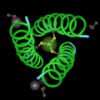We'll have a blast, I promise! But there's one little thing we need to discuss first...
I want to explain why I'm going to use nucleotide sequences for the blast search. (I used protein the other day). It's not just because someone told me too, there is a solid rational reason for this.
The reason is the redundancy in the genetic code.
Okay, that probably didn't make any sense to those of you who didn't already know the answer. Here it is.
The picture above shows the human genetic code (there are at least 16 variations on this, but that's another story). Each middle cell in the table shows the codons. Those are the groups of three bases in the left most column. Then, reading from left to right, we have the three letter and one letter abbreviations for the amino acids they encode. In every case, except for tryptophan (W), an amino acid can be encoded by multiple codons. (That's what we mean when we say the code is redundant. Oops, I said it again!)
Well, this means that we can have the same amino acid in a protein, but different codons in the mRNA.
So a protein sequence like this: FLAKEY
Could be encoded by the DNA sequence: TTTCTTGCCAAATAT
or the DNA sequenceTTCCTAGCAAAGTAC
These two sequences are only 70% identical but they code for amino acid sequences that are 100% identical.
Thus, you can see more variation at the level of the nucleotides.
One other thing, you might be wondering why there are T's in these sequences when the virus is made of RNA. Well, one reason is we usually make a DNA copy of RNA before we do any sequencing. The other reason, is that we store almost all sequences in the form of a DNA sequence, even when the sequences really did come from RNA.

um could u please post the whole human genetic code because i cant find it and i need it for some research. it would be nice though if they made a chart that shows which part of the human genetic code does which job :/ but that's unlikely it would make work allot easier though.
please reply.
Hi Zach,
The entire human genome sequence is way, way too large to post here. It wouldn't be very interesting reading either, since it's all A's, G's, T's, and C's.
There are charts though that do what different parts of the genome do. This book has a lot of information about where genes map in human genome and what they do: http://www.ncbi.nlm.nih.gov/books/NBK22183/
I think it would be a good place to start.